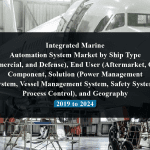OVERVIEW
The Space Debris Removal Market is currently valued at USD 0.2 billion in 2024 and will be growing at a CAGR of 41.7% over the forecast period to reach an estimated USD 0.6 billion in revenue in 2029. The space debris removal market is a burgeoning sector dedicated to addressing the escalating issue of space debris cluttering Earth’s orbit. With defunct satellites, spent rocket stages, and other remnants posing hazards to operational spacecraft and satellites, companies and organizations are pioneering innovative technologies and strategies for removal. These range from robotic arms and nets to propulsion-equipped spacecraft capable of deorbiting or relocating debris. With the growing congestion in space, fueled by increasing satellite launches, governments, space agencies, and commercial operators are recognizing the criticality of space sustainability. Consequently, investment in space debris removal technologies and services is on the rise, driven by both the necessity to safeguard space assets and the imperative to ensure the long-term viability of space exploration and satellite operations.
Firstly, the increasing number of satellites and spacecraft being launched into orbit contributes to the congestion in space, heightening the risk of collisions and the creation of more debris. This congestion underscores the necessity for effective debris removal solutions to maintain the sustainability of space activities. Secondly, as the reliance on satellites for communication, navigation, Earth observation, and other critical functions continues to expand, there is a growing recognition of the need to mitigate the risks posed by space debris to ensure uninterrupted satellite services. Thirdly, advancements in technology are enabling the development of innovative debris removal technologies, ranging from robotic arms to propulsion systems-equipped spacecraft, driving the market forward with promising solutions. Moreover, regulatory initiatives and international agreements aimed at addressing the space debris problem are creating incentives for investment and fostering collaboration among stakeholders. Together, these drivers are propelling the growth of the space debris removal market, positioning it as a crucial sector in ensuring the sustainability of space activities.
Table of Content
Market Dynamics
Drivers:
First off, when more satellites and vehicles are launched into orbit, space becomes more congested, increasing the likelihood of collisions and the amount of debris produced. The need for efficient debris removal solutions to preserve the sustainability of space activities is highlighted by this congestion. Furthermore, with the increasing dependence on satellites for vital tasks like communication, navigation, and Earth observation, there is an increasing awareness of the necessity to reduce the hazards associated with space debris in order to maintain satellite services. Thirdly, technological developments are making it possible to create novel debris removal methods, such as robotic arms and spacecraft outfitted with propulsion systems, which are propelling the business forward with encouraging answers. Moreover, international accords and legislative measures intended to solve the space debris issue are encouraging cooperation among parties and offering incentives for investment. When combined, these factors are accelerating the market for space debris removal and establishing it as a vital industry for maintaining the sustainability of space operations..
Key Offerings:
Key offerings in the space debris removal market encompass a range of innovative technologies and services aimed at mitigating the hazards posed by space debris. These offerings include spacecraft equipped with advanced propulsion systems capable of rendezvousing with and deorbiting debris, robotic arms and capture mechanisms for grappling and removing debris from orbit, and ground-based tracking and monitoring systems to enhance situational awareness and debris tracking. Additionally, companies may provide consultancy services for space debris mitigation strategies, including risk assessment, mission planning, and regulatory compliance. Some firms may also offer end-to-end debris removal missions, from initial assessment to execution, catering to the diverse needs of satellite operators, space agencies, and other stakeholders.
Restraints :
Although the industry for space debris cleanup has bright future prospects, there are a number of obstacles that could prevent it from growing. First off, smaller businesses and startups find it difficult to enter the market due to the large expenses involved in creating and implementing space debris removal technology, which discourages competition and innovation. Furthermore, significant experience and resources are needed to handle the technological difficulties and complexity of space debris removal operations, such as precisely tracking and catching debris, which raises costs and delays development schedules. Furthermore, while stakeholders negotiate liability issues and compliance requirements, the adoption of debris removal systems may be hampered by regulatory uncertainty and the absence of standard operating procedures for space debris mitigation. Moreover, cooperation attempts and the advancement of coordinated debris clearance projects may be hampered by geopolitical conflicts and international disputes over space governance and accountability. These limitations show how governments, industry players, and regulatory agencies must work together to overcome obstacles and realise the full potential of the space debris cleanup sector.
Regional Information:
• In North America, particularly in the United States, the space debris removal market is propelled by a robust ecosystem of aerospace industry players, including established corporations like SpaceX, Boeing, and Lockheed Martin, as well as innovative startups such as Astroscale US. With a strong focus on technological innovation and a supportive regulatory environment, North America leads in the development and adoption of space debris removal technologies and services. The region benefits from significant government funding for space exploration and defense initiatives, driving investment in space debris mitigation efforts. Additionally, partnerships between government agencies like NASA and private companies further stimulate growth and collaboration in the sector.
• In Europe, countries like France, Germany, and the United Kingdom are actively investing in space debris removal technologies, leveraging the expertise of organizations like the European Space Agency (ESA) and industry leaders like Airbus Defence and Space. Europe’s commitment to sustainable space activities and its collaborative approach to space exploration contribute to the region’s prominence in the global space debris removal market.
• In Asia-Pacific, countries such as Japan and India are emerging as key players in the space debris removal market, fueled by growing investments in space exploration and satellite technology. Japanese companies like Astroscale and Indian Space Research Organisation (ISRO) are spearheading efforts to develop innovative debris removal technologies, reflecting the region’s increasing importance in shaping the future of space sustainability.
Recent Developments:
• In October 2023, Astroscale Japan has been selected by Japan Ministry of Education, Culture, Sports, Science and Technology (“MEXT”) to inspect and remove a non-operational satellite. It consists of 3 phases of which the first phase is to send a spacecraft and monitor and track the debris for which it has granted 18 million. The total value of the contract is USD 80 million.
• In August 2023, Trans Astronautica Corporation. announced that it has received a contract from NASA to build an develop an orbital debris removal capture bag. Under this Trans Astronautica Corporation. will build and demonstrate the product.
Key Market Players:
Astroscale, Airbus Defence and Space, Lockheed Martin, Northrop Grumman, SpaceX, Boeing, ISRO, and ESA.
Frequently Asked Questions
1) What is the projected market value of the Space Debris Removal Market ?
– The Space Debris Removal Market is expected to reach an estimated value of USD 0.6 billion in revenue by 2029.
2) What is the estimated CAGR of the Space Debris Removal Market over the 2024 to 2029 forecast period?
– The CAGR is estimated to be 41.7% for the Space Debris Removal Market over the 2024 to 2029.
3) Who are the key players in the Space Debris Removal Market ?
– Astroscale, Airbus Defence and Space, Lockheed Martin, Northrop Grumman, SpaceX, Boeing, ISRO, and ESA.
4) What are the drivers for the Space Debris Removal Market ?
– The increasing number of satellites and spacecraft in orbit increases space congestion and debris risk. As satellites rely on communication, navigation, and Earth observation, there’s a growing recognition of the need to mitigate debris risks. Advancements in technology, regulatory initiatives, and international agreements are driving the growth of the space debris removal market, positioning it as a crucial sector for space sustainability.
5) What are the restraints and challenges in the Space Debris Removal Market ?
– The space debris removal market faces challenges such as high costs, technical challenges, regulatory uncertainties, and geopolitical tensions. These factors limit competition and innovation, and require substantial expertise and resources. The lack of standardized procedures, regulatory uncertainties, and geopolitical tensions may also hinder the adoption of debris removal solutions. To overcome these obstacles, industry stakeholders, governments, and regulatory bodies must collaborate.
6) What are the key applications and offerings of the Space Debris Removal Market ?
– The space debris removal market offers advanced technologies and services, including spacecraft, robotic arms, and ground-based tracking systems. Companies also provide consultancy services for mitigation strategies and end-to-end debris removal missions, catering to satellite operators, space agencies, and other stakeholders.
7) Which region is expected to drive the market for the forecast period?
– North America is expected to have the highest market growth from 2024 to 2029
Why Choose Us?
Insights into Market Trends: Global Market Studies reports provide valuable insights into market trends, including market size, segmentation, growth drivers, and market dynamics. This information helps clients make strategic decisions, such as product development, market positioning, and marketing strategies.
Competitor Analysis: Our reports provide detailed information about competitors, including their market share, product offerings, pricing, and competitive strategies. This data can be used to inform competitive strategies and to identify opportunities for growth and expansion.
Industry Forecasts: Our reports provide industry forecasts, which will inform your business strategies, such as investment decisions, production planning, and workforce planning. These forecasts can help you to prepare for future trends and to take advantage of growth opportunities.
Access to Industry Experts: Our solutions include contributions from industry experts, including analysts, consultants, and subject matter experts. This access to expert insights can be valuable for you to understand the market.
Time and Cost Savings: Our team at Global Market Studies can save you time and reduce the cost of conducting market research by providing comprehensive and up-to-date information in a single report, avoiding the need for additional market research efforts.












